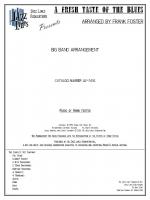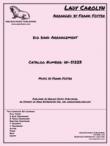FRESH TASTE OF THE BLUES, A
Written for the Count Basie Orchestra, Recorded by the SWR Big Band
Arranged by Frank Foster, Prepared by Dylan Canterbury, Rob DuBoff, and Jeffrey Sultanof

Cat #: JLP-7491
$75.00This item usually ships within 1 business day.
Questions?
Please call +1-518-587-1102 or email us.
Edition: Jazz Big Band Arrangement
Description: Swing - Advanced
Publisher: Jazz Lines Publications
Written for the Count Basie Orchestra but recorded by the SWR Big Band, A Fresh Taste of the Blues could almost be considered Frank Foster's answer to Duke Ellington's classic Diminuendo and Crescendo in Blue. Breaking from blues tradition with an extended 16 bar form, the chart begins at a fairly low-key level before slowly building across its 240 measure length to a grand climax. This arrangement was recorded in 1996 for the SWR Big Band album A Fresh Taste of Thad Jones and Frank Foster.
The first several choruses are reserved for solos that are spread across the ensemble. Beginning with a chorus of guitar, the order is as follows: two choruses of trombone with no backgrounds, two choruses of trumpet with trombone backgrounds on the 2nd chorus, and 2 choruses of alto sax with brass backgrounds on the 2nd chorus. The melody proper finally arrives at measure 113 in the unison saxes, with the brass filling in the gaps with some simple but effective riffs. The melody is passed to the trumpets at measure 129, with the ensemble complexity ramping up via chordal accompaniment in the saxes and a new counter-line in the trombones. The solos are not quite over yet, as the ensemble plays a quick send-off into a 2 chorus clarinet (or soprano sax) solo at measure 145.
The excitement really starts to ramp up at measure 177, the beginning of what becomes a 4 chorus ensemble shout. Although the volume level isn't exactly low at this point, your ensemble should do their best to hold back a little at first. Due to how long of a blow it is, a strong brass section with plenty of endurance is necessary to make this shout truly work to its maximum effect. The ensemble is largely in rhythmic unison, but the occasional break-aways from the saxes should stand out. The melody returns at measure 209, handled by the brass, but this time featuring some solo trumpet interjections in and around the ensemble's dense figures. By the time your ensemble reaches measure 225, they should be in full swing and at full volume, with some continued high note trumpet acrobatics soaring over the top of everything. The ensemble eventually comes to a seemingly abrupt halt for a trumpet cadenza before ultimately roaring back to life for one final held blast.
This arrangement is for jazz big band with clarinet or soprano sax soloist. It is not a transcription - it has been engraved from Frank Foster's original score. Foster provided instructions to make use of this arrangement as a potential concert opener that are as follows:
"At the start of the performance, the only people on stage should be the rhythm section, with the rest of the band gradually walking on stage. First up is the trombone soloist, who begins soloing while walking out onto the stage. at measure 17. The remainder of the trombone section should be on stage and in place by the beginning of the trumpet solo at measure 49. The trumpet soloist should likewise begin their solo while walking out onto the stage with the rest of the section joining them by measure 81. The alto sax solo follows suit, heading out while soloing at measure 81, with the rest of the section joining them by the start of the melody at measure 113."
Solo Clarinet
2 Alto Saxophones
2 Tenor Saxophones
Baritone Saxophone
4 Trumpets
4 Trombones
Guitar
Piano
Bass
Drums
Trumpet 2 and 3: Eb6
Trombone 1: Bb4




![SHINY STOCKINGS [DOWNLOAD] View: SHINY STOCKINGS [DOWNLOAD]](https://www.ejazzlines.com/wp-images/product/thumbnail/shiny_stockings_jlp-51207.jpg)







